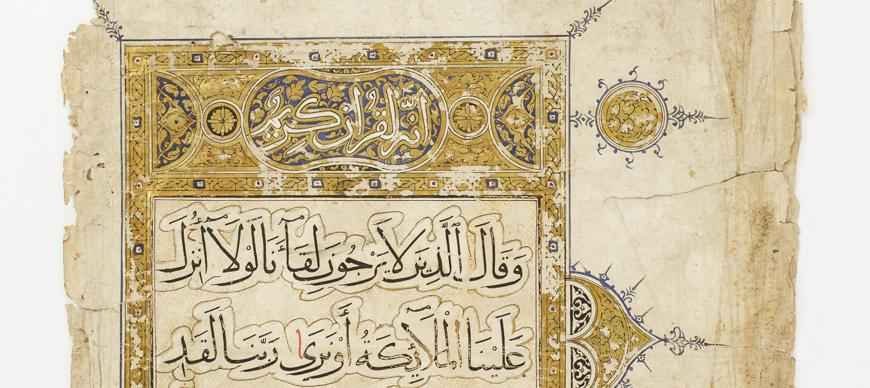Exhibition Shows How Christians, Muslims, Jews Created Vibrant Society in Medieval Cairo

This following appeared on UChciago News on 16 February 2015:
A new exhibition at the University of Chicago’s Oriental Institute Museum will offer a glimpse into everyday life in a lively, multicultural city in ancient Egypt. “A Cosmopolitan City: Muslims, Christians, and Jews in Old Cairo” features many objects that have never been displayed in the museum before and shows how people of different faiths interacted to create a vibrant society. The exhibition is on view from Tuesday, Feb. 17 through Sept. 13.
The exhibition sheds light on Egypt in the time between the pharaohs and the modern city, roughly 650–1170 AD, when the main population lived in the area known as Fustat, located in today’s southern Cairo. Fustat was established in 641 by the first Muslim ruler of Egypt, ‘Amr Ibn al-‘As. His administration included Christians, whose community was established there some 600 years before, and Jews, who had settlements in the Nile Valley for over a millennium.
"So much is known about Fustat from written sources,” said Jack Green, chief curator of the Oriental Institute Museum. “This exhibit also presents some the material possessions of the community, providing insights into the everyday lives of the people who lived in this bustling city.”
Visitors will explore how Old Cairo’s communities lived together and melded their traditions to create a multicultural society. The neighborhoods of Fustat were populated by people from a patchwork of religious and ethnic communities, including native Egyptians and immigrants from Arabia, North Africa, and other regions of the Middle East.
The exhibition focuses on the three main religious communities—Muslims, Christians and Jews—whose members, living in “peaceful co-existence,” helped shape Old Cairo’s neighborhoods, markets and public places. With the help of Christian and Jewish officials, a Muslim governor headed the administration of Fustat—the commercial and financial capital of Egypt.
For much of Fustat’s history, the people did not express their religion through distinctive clothes, food or occupations. However, the different languages (Arabic, Coptic and Hebrew) and major architectural landmarks, including the Ben Ezra Synagogue (one of several in Fustat), the church of St. George, Abu Serga and al-Mu’allaqa (the “Hanging Church”), and the mosques of ‘Amr and Ibn Tulun—all of which can still be visited today—served as reminders of the diversity of the population.
The show reveals patterns of life in Fustat by exploring the topics of taxes, administration and industry, as well as more personal aspects of life, such as dining, leisure, family life and adornment.
Most of the 75 objects in the exhibition have never before been on display. They include richly illuminated Korans, Coptic and Hebrew manuscripts, ceramics, textiles, jewelry and architectural fragments. Other objects, such as game pieces and dolls, vividly remind the visitor of life in the city more than 1,000 years ago. Many of the artifacts were excavated at Fustat by the American archaeologist George Scanlon between 1964 and 1972.
The show includes important objects recently “rediscovered” in the collection of the Oriental Institute Museum by Tasha Vorderstrasse, PhD and research associate at the Oriental Institute, who conducted a survey of the Islamic-era material in the museum’s holdings.
Among the objects Vorderstrasse re-identified are parchment pages from the Cairo Genizah, a famed deposit of Jewish manuscripts preserved for centuries at the Ben Ezra synagogue. According to Jewish tradition, objects inscribed with the name “God” or in the Hebrew script were thought to be sacred, and rather than being discarded, they were preserved in an enclosed space in the temple. The contents of the Genizah helped to document all aspects of life in medieval Egypt and the surrounding areas.
Other new discoveries include papyri written in elegant flowing Arabic script by Qurra ibn Shark, the governor of Fustat from 709 to 714. In these documents, Qurra corresponds with Christians and Jews outside Fustat concerning the cultivation of land and other matters related to the smooth running of the state. The correspondence reflects Qurra’s fairness in assessing taxes and dealing with local disputes with non-Muslims.
Another important object in the exhibition, also from the Ben Ezra Synagogue, is an elaborately carved door from the temple’s ark—the cabinet that held the sacred Torah. The door, which dates to about 1030, is carved with a passage in Hebrew from Psalm 118:19: “Open to me the gates of righteousness, that I may enter through them and give thanks to the Lord.”
Like many of the objects from Fustat, its decoration reflects the city’s different communities by incorporating both Jewish texts and Islamic design motifs. The door, from the permanent collection of the Walters Art Museum, Baltimore, and the Yeshiva University Museum of New York, is on view in the Midwest for the first time.
Old Cairo’s communities will be brought to life through modern readings of the thoughts and memories of the people who lived there. These recordings, which can be listened to on iPads in the exhibition, include people describing their city and everyday experiences: a woman writing to her neglectful son, selections from the writings of the 12th-century poet Moses ben Abraham Dari, the daily routine of the famed 12th-century physician Moses Maimonides, and descriptions of Fustat.
The curators of “A Cosmopolitan City: Muslims, Christians, and Jews in Old Cairo,” Vorderstrasse and Tanya Treptow, PhD in Islamic Archaeology, collaborated with Donald Whitcomb, assistant professor of Islamic Archaeology at the Oriental Institute.
A fully illustrated catalog with essays on many aspects of Fustat is available both in the Oriental Institute bookshop and online: http://oi.uchicago.edu/museum-exhibits/special-exhibits/cosmopolitan-city-old-cairo.
The exhibition and many of the associated programs are made possible by the generous support and collaboration of the Franke Institute for the Humanities, the Center for Jewish Studies, the Center for Middle Eastern Studies, and the Divinity School at the University of Chicago.